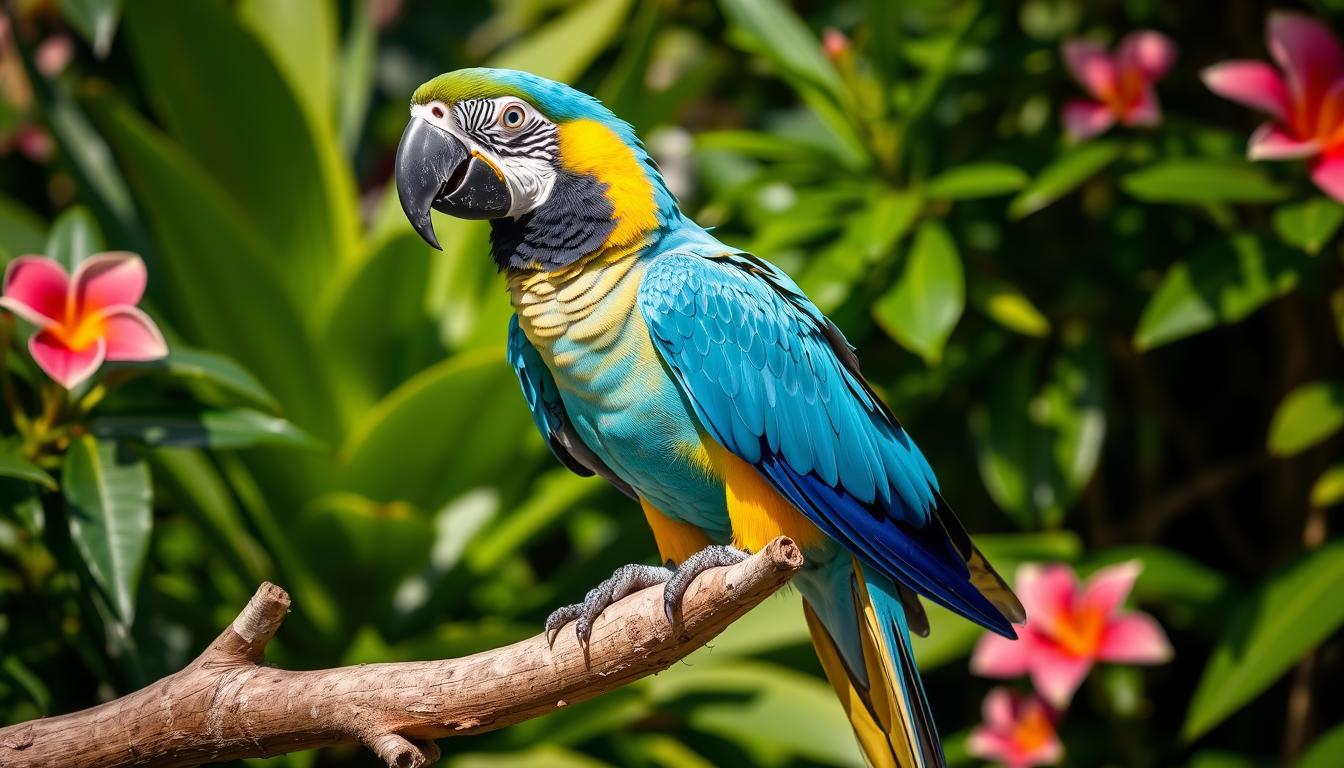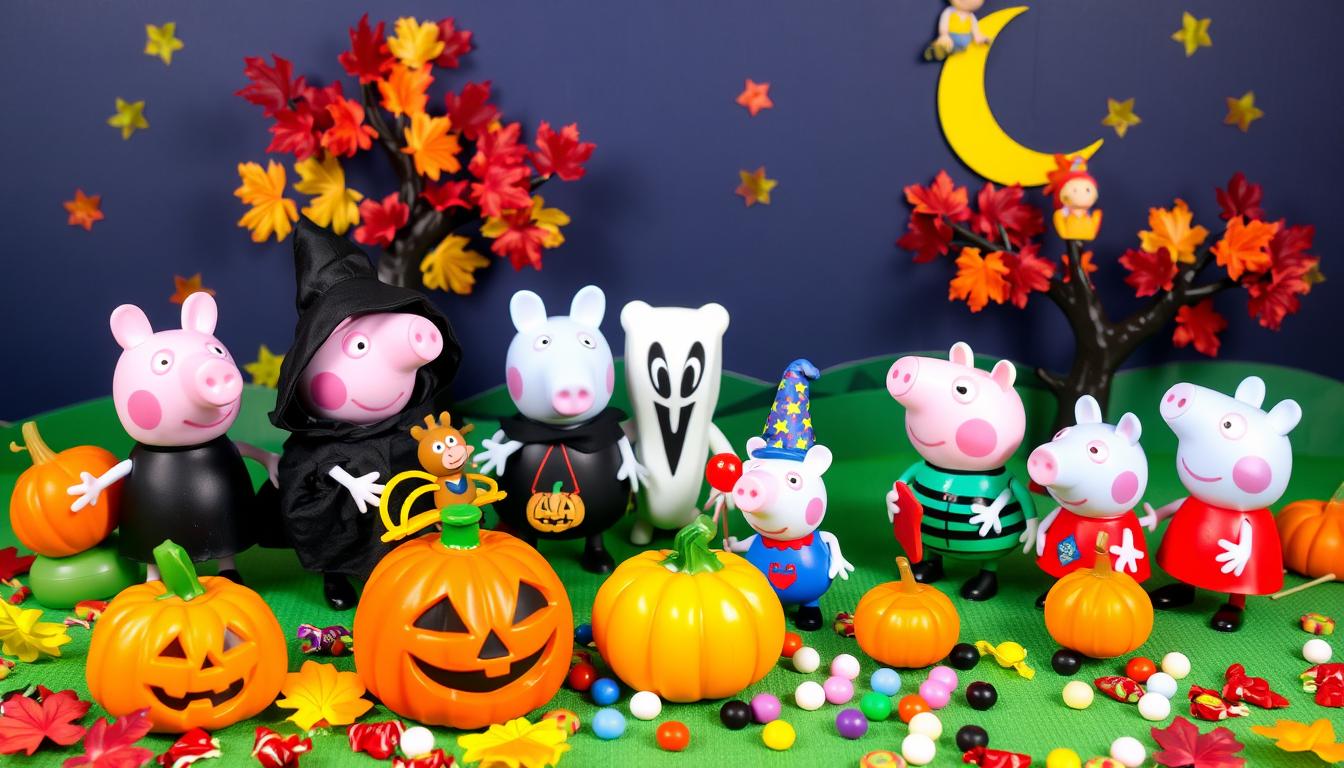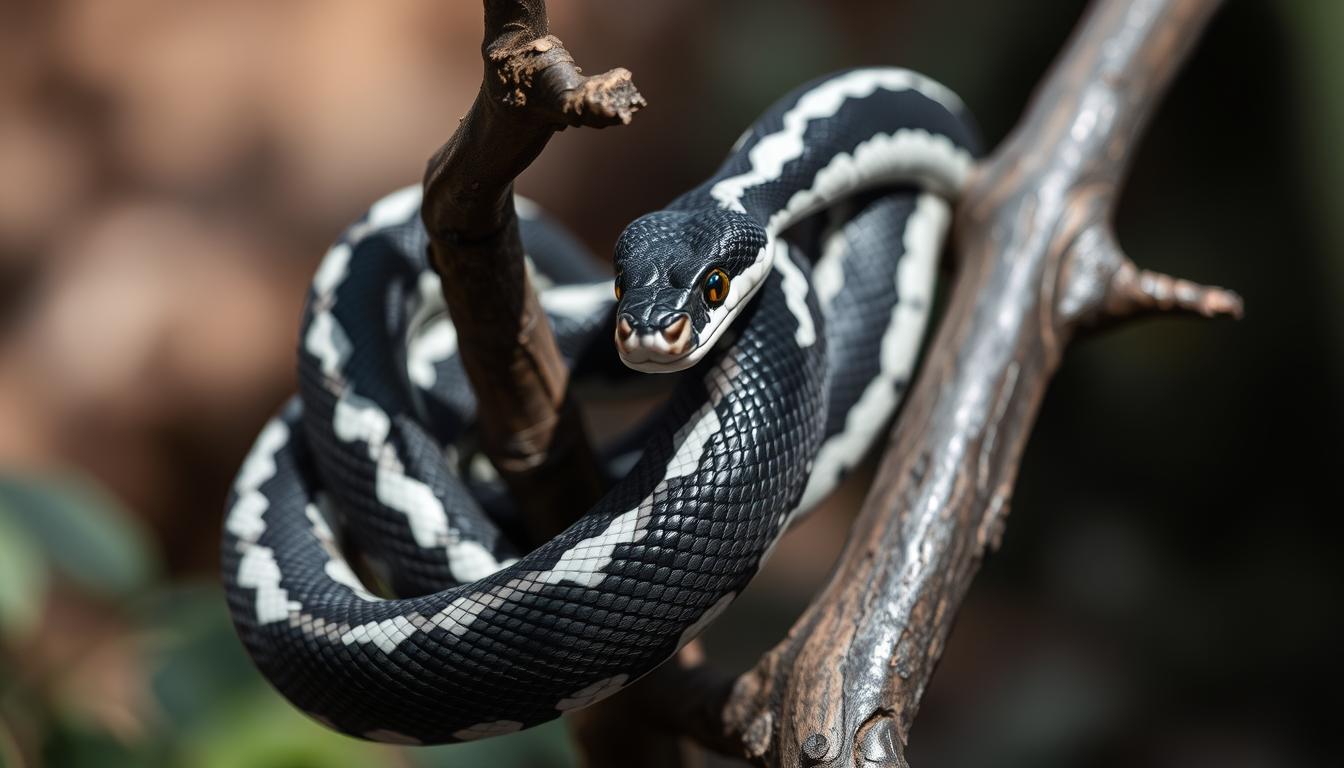Australian Rainbowfish: Colorful Aquarium Gems
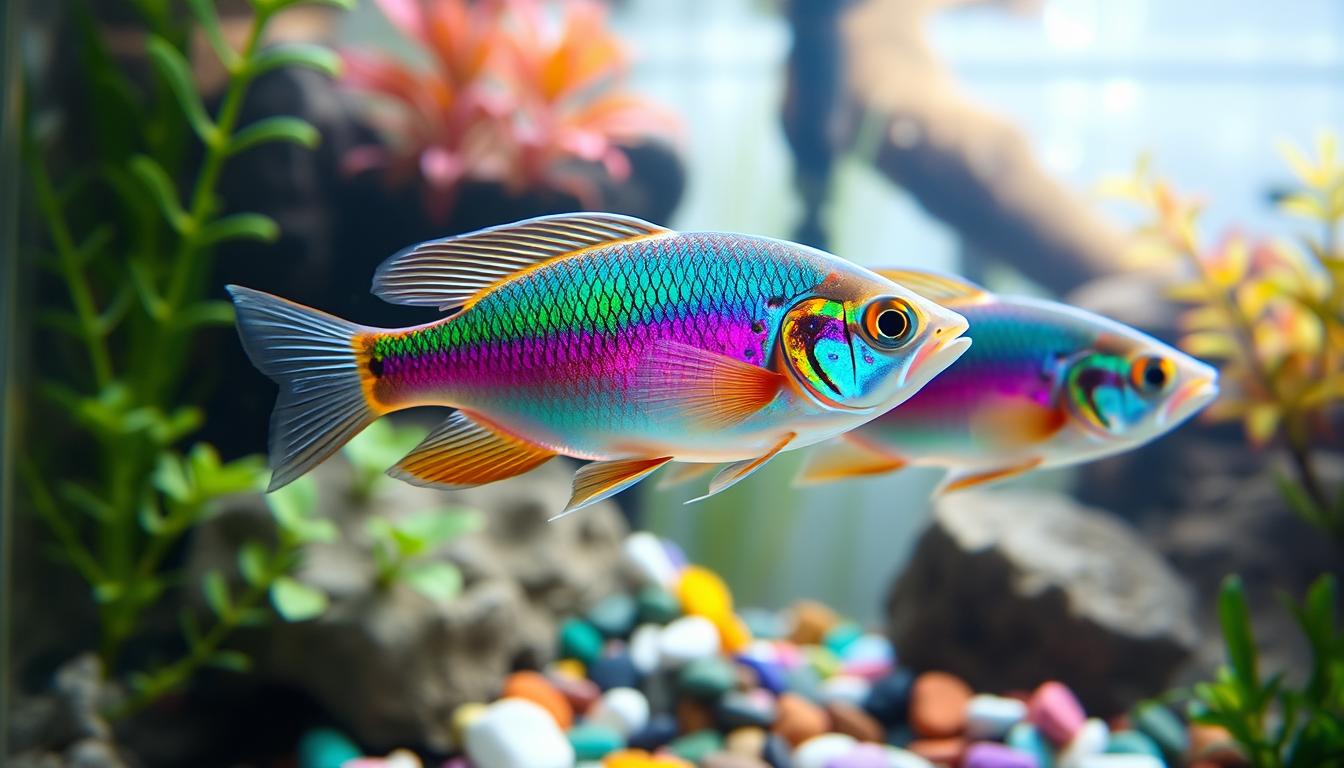
In aquariums worldwide, the Australian Rainbowfish shines brightly. It has over 50 species, many of which are rare12. Their scales shimmer in a rainbow of colors, making them a favorite for their beauty and lively nature. They thrive in clear, slightly warm water, similar to their natural habitats.
They do well in tanks with dark substrates and live plants like Java moss and Crested Java Fern1. These colorful fish are perfect for both beginners and experienced aquarists2.
Key Takeaways
- Australian Rainbowfish add vibrant colors and life to any tank.
- They need a tank of 20-50 gallons, depending on the number of fish2.
- Their habitat should have plants, a pH of 6.5 to 7.6, and temperatures between 72°F and 82°F for health12.
- They adapt well to soft to medium water, making them great for beginners2.
- Eating high-quality fish flakes and live foods like bloodworms keeps them vibrant12.
- Regular water changes of 25% weekly or 50% biweekly keep the tank healthy1.
Exploring the Origins of Australian Rainbowfish
Australian rainbowfish are known as freshwater jewels. They come from tropical waters in areas full of aquatic plants. Their ability to live in Australia, New Guinea, and Indonesia shows their strength and the importance of their environment.
Looking into where these colorful fish come from, we see they started in a lush, plant-rich setting. This place was both safe and a key food source for them.Learn more about creating vibrant aquariums.
The Evolution and Natural Habitat of These Freshwater Jewels
Studies show rainbowfishes began evolving 17 to 20 million years ago. This was before big changes in their habitats3. Over time, they developed into the different types we see today. This happened because of their unique adaptations to diverse, plant-rich ecosystems.
Regional Variations and the Biodiversity of Australian Rainbowfish
Australian rainbowfish show a lot of diversity. Scientists have found between 15 to 20 new species, with many in Australia3. Their differences are shaped by their habitats and geography. For example, the rising Highlands of New Guinea have influenced their evolution3.
| Feature | Description | Impact on Biodiversity |
|---|---|---|
| Geographical Isolation | Rising terrains in the central Highlands of New Guinea | Speciation and unique adaptations in local populations |
| Undescribed Species | 15-20 species, with significant presence in Australia | High regional biodiversity underscoring undiscovered genetic variations |
| Evolutionary History | Origins dating back to 17-20 million years ago | Long-term adaptation and survival across diverse environments |
Learning about their evolution and habitats helps us appreciate these fish more. It also helps us protect and manage them in both their natural homes and aquariums.
Creating the Perfect Aquarium Setup for Australian Rainbowfish
To give Australian rainbowfish the best home, create a balanced aquarium setup. This setup should look like their natural habitat to keep them healthy and colorful. Adding aquatic plants is also key for their well-being.
Start by picking the right tank size. For these fish, a 20-gallon tank is good for smaller species. But, larger species need a 30-gallon or bigger tank. This size ensures they have enough room to swim and stay stress-free.
Then, focus on aquascaping to make the tank look like their natural home. Use various aquatic plants for decoration and to give them places to hide. Plants like Java Fern and Anubias can handle the nibbling of larger fish, unlike finer plants4.
Add driftwood and rocks to make the tank look like their native creeks and rivers. This not only looks good but also helps keep the ecosystem balanced. It supports their health and shows off their bright colors, which vary by origin4.
Keep the water clean by checking the levels often. Australian rainbowfish like water between 75–82°F (24–28°C) and a pH of 6 to 8. Use a good filter and gentle water flow to keep them active and healthy.
For a happy rainbowfish community, remember their social nature. Keep a 1:1 male to female ratio to see their best displays in the mornings4. Also, pair them with similar species to avoid bullying, especially with smaller “blue eyes” rainbowfish4.
Feed them a varied diet to keep them healthy and colorful. Use meaty foods like krill flakes, frozen bloodworms, and brine shrimp. This diet supports their omnivorous nature and keeps them looking their best5.
By setting up your tank with enough space, the right water, and lots of plants, you can create a great home for Australian rainbowfish. It will look like their natural habitat and show off their beautiful colors and behaviors.
The Diverse Color Variations of Australian Rainbowfish
Being a fan of Australian Rainbowfish means you love their diverse color variations, breeding colors, and how genetic influence on color works. With over 50 types worldwide2, these fish show off a wide range of colors. These colors get even brighter during breeding season, especially in males, to draw in mates2.
Understanding the Genetics of Color in Rainbowfish
Genetics are key in determining the colors of Australian Rainbowfish. The genes they inherit affect their colors and how these colors change over time. This genetic variety is why even similar fish can look very different6. Knowing about the various types of Rainbowfish helps aquarists prepare for the vibrant colors they might see in their tanks.
The Phenomenon of Color Change During Mating Season
The breeding season brings a stunning change in Rainbowfish colors. Males get brighter and more colorful to attract females. This change is due to their genes and the environment6. Breeders need to understand this to improve the breeding colors for beauty or competitions.
Want to learn more? Check out resources like The Ultimate Guide to Keeping Pet. It has tips on tank conditions and diet that can help keep Rainbowfish colors bright.
The mix of genetic influence on color and good tank care makes Rainbowfish a joy to watch. They add a splash of color to your home aquarium. Let your tank be a showcase of Australian Rainbowfish colors.
Behavioral Characteristics and Temperament of Australian Rainbowfish
Thinking about adding Australian Rainbowfish to your aquarium? It’s important to know their behavior and temperament. These fish are known for being peaceful and enjoy being in groups. Watching them interact can add a lot of joy to your aquarium.
Australian Rainbowfish are great for shared tanks because they’re not aggressive. They like to be with others, which makes them good friends for many fish species.
| Parameter | Recommended Condition | Our Tank Settings |
|---|---|---|
| Size | 9-11 cm (3.54-4.33 inch) | 10 cm average size observed |
| pH Level | 6.5 – 7.5 | 7.0 maintained in our tanks |
| Water Hardness (dGH) | 4 – 14°N (71.43 – 250 ppm) | 10°N (178.5 ppm) |
| Temperature | 22 – 26 °C (71.6 – 78.8°F) | 24 °C (75.2°F) |
| Tank Size | 150 liters (40 gallons) for 6 fish | 200 liters (53 gallons) for 8 fish |
| Water Change Frequency | Weekly, 25%7 | Weekly, 30% |
A tank of at least 150 liters is best for these active fish. It gives them enough room for 6 fish, helping them feel secure and happy7. Keeping them in groups also helps keep the aquarium healthy.
It’s key to keep the water quality good for these fish. Make sure the pH is between 6.5 and 7.5, and the water hardness is 4 – 14°N7. This helps them stay healthy.
Australian Rainbowfish are a wonderful choice for any aquarium. Their lively nature and beautiful colors make them a joy to watch. They add a lot of interest to your aquarium, showing the beauty of aquatic life.
An In-Depth Care Guide for Australian Rainbowfish
Caring for Australian rainbowfish is rewarding when you know their needs. This includes their habitat and diet. We’ll cover the water parameters and aquascaping needs for a thriving environment.
Maintaining Ideal Water Parameters and Quality
Keeping the water right is key for your rainbowfish’s health. They like temperatures between 72-78°F (22-26°C) and a pH of 6.5 to 7.5. It’s important to check the water often for ammonia, nitrite, and nitrate levels to avoid health problems (detailed care guidelines). Changing 25% of the water weekly helps keep it clean8.
Designing a Species-Specific Aquascaped Environment
Creating a habitat that looks like their natural home is important. You’ll need dense plants and open swimming areas. Adding driftwood, rocks, and plants not only looks good but also gives them places to hide and feel safe. For a group, a 45-liter tank is the minimum, but bigger tanks are better for more fish or for species that like to swim together8.
| Parameter | Value |
|---|---|
| Temperature | 72-78°F (22-26°C) |
| pH Level | 6.5-7.5 |
| Ammonia | 0 ppm |
| Nitrite | 0 ppm |
| Nitrate | Less than 20 ppm |
| Water Hardness | 8-20 dGH |
| Recommended Tank Size | 45 liters and up |
Knowing and using these care tips will make your rainbowfish aquarium come alive. By following these guidelines, you’ll create a healthy space for them to thrive and live long, colorful lives8.
Feeding Habits: Nourishing Your Australian Rainbowfish
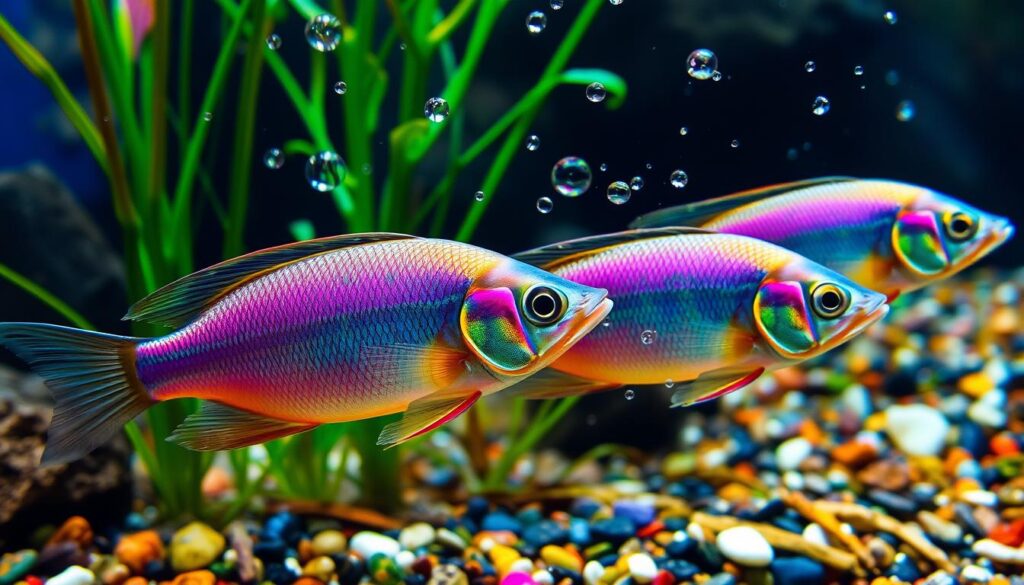
It’s important to know how to feed your Australian Rainbowfish right. They need a diet that’s both plant and animal-based. This mix helps them stay healthy and look their best.
Choosing the Right Diet for Optimal Color and Health
To keep your Australian Rainbowfish looking vibrant, feed them a variety of foods. Foods with spirulina help their colors pop. Live or frozen foods like brine shrimp and bloodworms also help.
These foods not only taste good but also give them the protein they need. Protein is key for their growth and health. It makes their colors shine and their scales look great9.
The Balance of Plant and Animal-Based Foods
It’s important to balance their diet with both plants and animals. They love meat, but they also need plants. Foods like vegetable flakes and peas are good for them.
These foods give them vitamins and help with digestion. But, too much protein can be bad. So, a balanced diet is best. It keeps them healthy and happy in their tank.
Choosing the right foods can really make a difference. Feed them often but in small amounts. This keeps their tank clean and them healthy.
Remember, how you feed them shows in their beauty. Following these tips will make your Australian Rainbowfish thrive. It will also make your aquarium a stunning place to be.
Breeding Tips for Australian Rainbowfish Enthusiasts
Starting to breed Australian rainbowfish can be both tough and rewarding. It’s key to know the spawning process and how to care for the fry. This section gives you the lowdown on breeding these fish and tips to improve your chances.
To start the breeding, feed the fish a diet rich in protein. Include live foods like white worms, blood worms, and brine shrimp. This diet helps trigger their breeding behavior10. Spawning usually happens from October to January, with females laying 100 to 150 eggs daily for several days10.
After the eggs are laid, keeping the water just right is crucial. The eggs hatch in 5 to 9 days if the water is between 24 and 29°C10. Make sure the water’s pH is between 6.5 and 8.5 and the general hardness (GH) is between 8 and 25 for the best conditions10.
Once the fry hatch, they need good food to grow. Start with infusoria and then move to baby brine shrimp. This ensures they get the nutrients they need. It’s important to watch them closely as they grow, especially in the first year after hatching10.
For those wanting to learn more about the diet and eating habits of Australian rainbowfish, mixing live and commercial foods is key. Terrestrial insects, which can make up to 100% of their diet, are especially good for their health and color11.
| Phase | Description | Duration |
|---|---|---|
| Conditioning | High-protein diet, increase in live foods | 2-4 weeks |
| Spawning | Female lays eggs, daily over several days | October to January |
| Incubation | Eggs hatch with controlled water temperatures | 5-9 days |
| Fry Rearing | Starts with infusoria, transitions to brine shrimp | Up to 12 months |
Following these Australian rainbowfish breeding tips will help you create a successful breeding setup. It supports the health and growth of young fish and helps preserve this unique species1011.
Selecting Compatible Tank Mates for Australian Rainbowfish
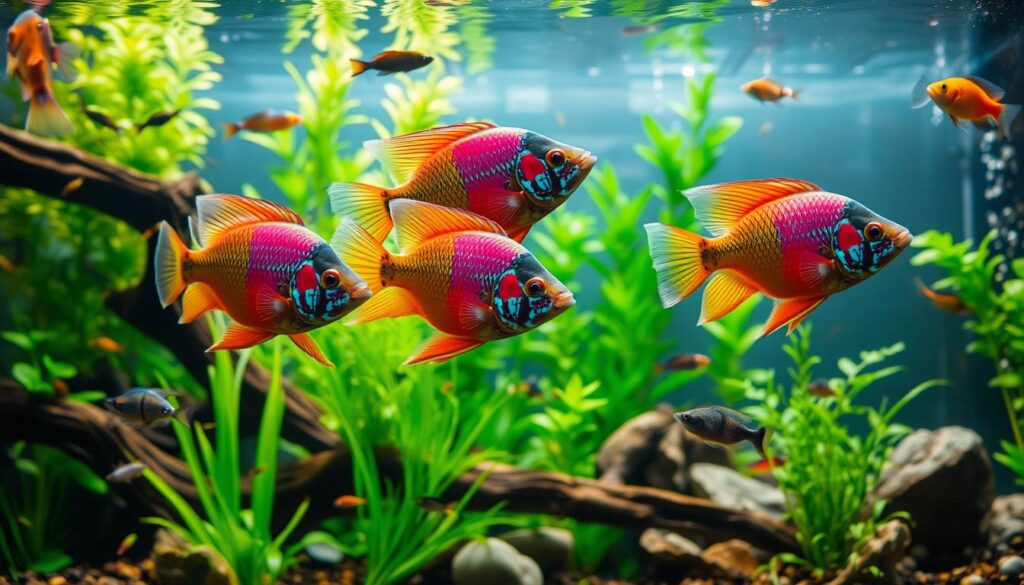
Setting up a colorful and calm aquarium for your Australian Rainbowfish is key. It’s important to pick tank mates that get along well. This helps keep stress low and creates a peaceful space for all.
Understanding Social Behaviors and Community Dynamics
Australian Rainbowfish are friendly and colorful, perfect for a community tank. But, not all fish are good friends for them. Look for tank mates that like the same water and are calm. For example, tetras and guppies are great because they’re active and colorful12.
Tips for Preventing Aggression and Stress
Keeping your tank balanced is vital to avoid stress. Watch how fish interact and keep the right number of species. For instance, Cherry Barbs are peaceful and get along with Rainbowfish12. Also, think about the size of the fish; Giant Danios are big but can live with Rainbowfish12.
Here’s a table showing good and bad tank mates for Australian Rainbowfish:
| Species | Compatibility Rating | Comments |
|---|---|---|
| Giant Danios | A | Proven companions since 2012, similar size to Rainbowfish13. |
| Mbuna Cichlids | F | Not recommended due to aggression13. |
| Neon Jewel Cichlids | C | Potential for aggression, careful monitoring required13. |
| Tiger Barbs | B | Can be dither fish for more aggressive species, moderate compatibility13. |
| Cherry Barbs | A | Peaceful and good community fish12. |
When picking tank mates for your Australian Rainbowfish, follow these tips. This will help create a beautiful and stress-free aquarium. The secret to a healthy tank is balance and harmony among the fish. Always watch how new fish behave and adjust as needed.
The Importance of Sustainable Fishkeeping with Australian Rainbowfish
As aquarium lovers, it’s our duty to keep fishkeeping sustainable. This protects the homes of Australian rainbowfish. These colorful fish, like the Dwarf Neon and Red rainbow, make our tanks beautiful. But, we must think about their welfare too.
To protect these fish, we should only keep ones bred in captivity. This helps keep their natural habitats healthy. Their homes range from Australian rivers to New Guinea lakes, including special places like “Blue-eyes” waters1415.
Shopping at Angels Pet World can help you make better choices for your fish. Rainbowfish need friends and the right tank size to thrive. They can live up to 10 years with the right care15.
Knowing their needs, like the right temperature and water, is key. This keeps them healthy and happy14.
Also, changing the water weekly helps keep their environment clean. This keeps diseases away and makes their home more like their natural one14.
Our goal is to enjoy their beauty while also caring for their future. Keeping species like Boeseman’s and Threadfin rainbowfish healthy is a big responsibility. It’s about preserving their beauty for generations to come14.
FAQ
What is the ideal aquarium size for Australian Rainbowfish?
Can Australian Rainbowfish be kept with other fish?
How do I ensure my Australian Rainbowfish retain their vibrant colors?
What are the best conditions for breeding Australian Rainbowfish?
What type of diet is suitable for Australian Rainbowfish?
How do I replicate the natural habitat of Australian Rainbowfish in my aquarium?
What water parameters are ideal for Australian Rainbowfish?
How do Australian Rainbowfish behave in an aquarium?
What are the best practices for sustainable fishkeeping of Australian Rainbowfish?
Is there a difference in coloration among Australian Rainbowfish?
Source Links
- https://livefish.com.au/freshwater/rainbows – Rainbow Fish
- https://www.ouraquariumlife.com/fish/australian-rainbow-fish/ – Australian Rainbow Fish: Size, Care & Tank Mates
- http://www.angfaqld.org.au/aqp/blog/2013/08/13/rainbowfish-species-diverged-earlier-than-thought/ – Rainbowfish species diverged earlier than thought
- https://www.plantedtank.net/threads/setting-up-a-rainbow-tank-thought-please.499641/ – Setting up a Rainbow tank- thought please
- https://www.aquariumcoop.com/blogs/aquarium/boesemani-rainbowfish?srsltid=AfmBOorXUrn6k6qadKTNrT8lr9eFbQZgAEmVJjX2dWVAKeCalqSgUu6n – Care Guide for Boesemani Rainbowfish — Tank Setup, Breeding, and More
- https://www.ouraquariumlife.com/fish/types-of-rainbow-fish/ – 16 Colorful Types of RainbowFish
- https://en.aqua-fish.net/fish/australian-rainbowfish – Australian Rainbowfish (Melanotaenia fluviatilis) – Care, Diet, Breeding & Lifespan
- https://ornamentalfish.org/wp-content/uploads/Rainbowfish.pdf – PDF
- https://delfishies.wordpress.com/tag/australian-bass/ – Australian Bass – Del talks fish and aquariums!
- https://aquadiction.world/species-spotlight/murray-river-rainbowfish/ – Murray River Rainbowfish – Melanotaenia fluviatilis Fish Profile & Care Guide
- http://blogs.thatpetplace.com/thatfishblog/2013/06/26/australian-rainbowfish-the-natural-diet-of-a-popular-freshwater-fish/ – Australian Rainbowfish – the Natural Diet of a Popular Freshwater Fish
- https://aquariumlabs.water.blog/2022/04/08/19-best-rainbow-fish-tank-mates/ – 19 Best Rainbow Fish Tank Mates
- https://www.cichlid-forum.com/threads/rainbowfish-compatibility-with-malawian-cichlids.426058/page-2 – Rainbowfish Compatibility with Malawian Cichlids
- https://www.thetropicaltank.co.uk/keeping_rainbowfish.htm – Keeping Rainbows in the Aquarium
- https://uk.zooexperte.com/rainbowfish – Tips on Feeding and Keeping Rainbowfish

